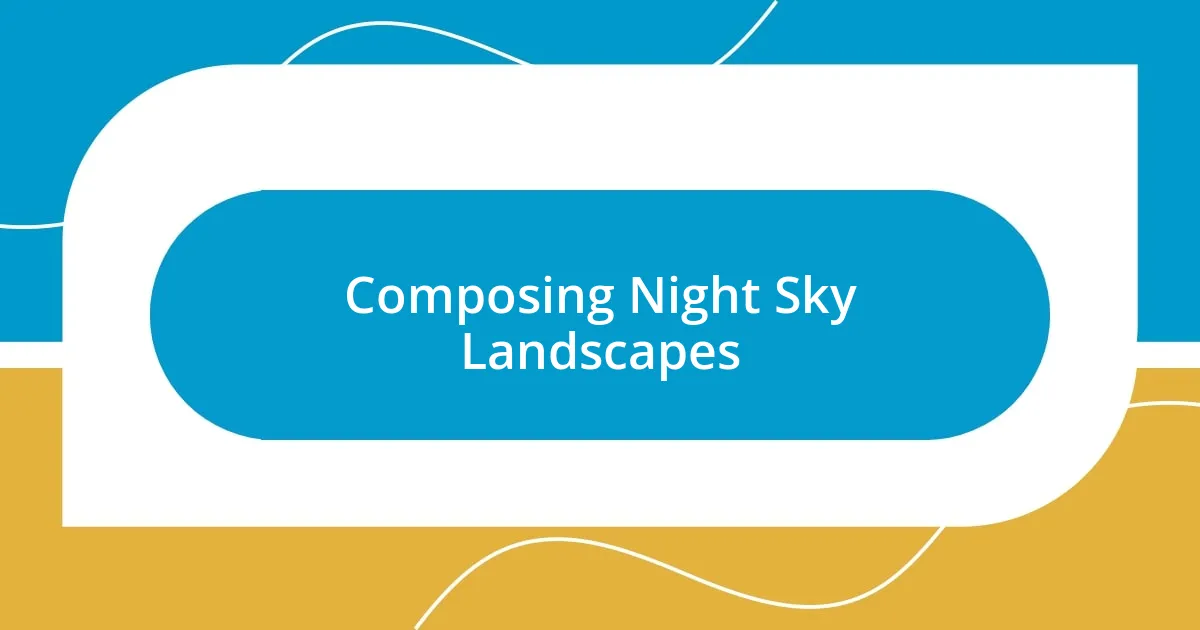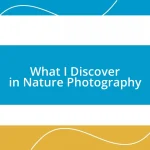Key takeaways:
- The beauty of night sky landscapes evokes feelings of wonder and introspection, connecting humanity through shared experiences of stargazing.
- Successful night sky photography requires careful planning, including choosing the right location, checking weather conditions, using proper equipment, and mastering camera settings.
- Techniques such as the “500 rule,” manual focus, and thoughtful composition enhance the quality of night sky images, transforming ordinary shots into captivating stories.
- Post-processing is crucial for enhancing images, involving adjustments to brightness, noise reduction, and color calibration to evoke specific moods and preserve celestial details.

Introduction to Night Sky Landscapes
There’s something undeniably enchanting about a landscape illuminated by the night sky. I remember the first time I gazed at a clear expanse of stars during a camping trip in the mountains. It struck me how vast and mysterious the universe feels under the glow of those distant suns—doesn’t it make you wonder what secrets lie beyond our reach?
As I stood there, surrounded by towering pines and the gentle rustle of leaves, I felt a profound connection to nature. The contrast between the dark silhouette of the trees and the shimmering constellations overhead created a breathtaking masterpiece. Have you ever experienced that moment when the beauty of the night sky takes your breath away? It’s as if the cosmos holds a mirror to our souls, inviting us to reflect on our place in this expansive universe.
Night sky landscapes aren’t just about the celestial display; they encapsulate the feelings of wonder and introspection that come when we look upward. With each star twinkling like a distant promise, I realized that these moments remind me of our shared humanity. Isn’t it fascinating to think that people across the globe, throughout history, have stood beneath the same stars, each one creating their own stories inspired by the night sky?

Preparing for Night Sky Photography
Preparing for night sky photography takes a bit of planning, but the reward is worth it. I still vividly remember the first time I ventured out with my camera, feeling a mix of excitement and nervousness. The thrill of capturing the shimmering Milky Way was a quest that turned into pure magic once everything clicked into place. Setting up my equipment in a remote location, away from city lights, was crucial.
Here are some essential tips to get you started:
- Choose the Right Location: Look for spots with minimal light pollution; national parks or remote areas are great choices.
- Check the Weather: A clear sky is essential, so plan your shoot for a night with no cloud cover.
- Timing is Key: The best time for night sky photography is during the new moon or when the moon is below the horizon.
- Bring the Right Gear: A sturdy tripod, wide-aperture lens, and extra batteries are must-haves.
- Practice Your Settings: Familiarize yourself with camera settings like ISO, shutter speed, and aperture before heading out.
I remember fidgeting with my camera settings in the cold night air, my breath visible as I adjusted everything to ensure that the stars would shine in all their glory. Getting used to the darkness around me was part of the experience, adding to the thrill of the chase. It became a mindful moment; each click of the shutter felt like a conversation with the universe, one I was eager to continue.

Techniques for Capturing Stars
Capturing stars on camera is truly an art that requires a blend of technique and intuition. I recall one magical night, sitting under the expansive sky, with my lens pointed straight at a vibrant cluster of stars. As I fiddled with the exposure settings, I learned that longer exposures can reveal more stars, but it’s essential to balance that with the risk of star trails—unless, of course, that’s the effect you want. Incorporating a wide-aperture lens can work wonders, allowing more light to flood in and bringing out those subtle colors of the night sky that our eyes often miss.
One technique I frequently employ is the “500 rule.” This simple math helps determine the longest exposure time without noticeable star trails. By dividing 500 by the focal length of my lens, I’ve achieved crisp, clear shots time after time. For example, if I’m using a 24mm lens, my longest exposure should be about 20 seconds (500 ÷ 24). When I first experimented with this method, it felt like unlocking a secret door to the galaxy, where each click revealed layers of the cosmos I’d never seen before.
In addition to exposure, focus plays a critical role in capturing those breathtaking night sky images. I generally recommend switching to manual focus, especially in dim conditions when autofocus can struggle. I remember one night where I completely missed the perfect shot because my camera was still hunting for that elusive focus point among the stars. Now, I take a moment to focus on a distant bright star before composing my shot, ensuring that each twinkle is as sharp and stunning as the universe itself.
| Technique | Explanation |
|---|---|
| Long Exposure | Allows more light into the lens, capturing more stars, but watch for star trails. |
| 500 Rule | Calculates maximum exposure time to minimize star trails; 500 divided by the lens focal length. |
| Manual Focus | Ensures sharp images by focusing on a distant star, rather than relying on autofocus. |

Composing Night Sky Landscapes
When composing night sky landscapes, your foreground plays a crucial role in adding depth and context to the vastness of the sky. I fondly recall one outing where I positioned my camera near an old tree, its gnarled branches silhouetted against the Milky Way. This contrast not only anchored the composition but also evoked a sense of wonder. Have you ever noticed how an interesting foreground can transform an image? It makes the stars feel more inviting, as if they’re beckoning us to step into the scene.
I often find that leading lines can guide the viewer’s eye through my photographs. For instance, while taking shots of a winding river under a starry sky, I allowed the water to create a natural path that led up to the constellations above. This technique can dramatically enhance how the viewer navigates the image, creating a visual journey. Really, it’s about telling a story, one where the night becomes not just a backdrop but a central character in the landscape.
Another personal tip is paying close attention to the rule of thirds. Dividing the frame into three sections, both horizontally and vertically, has helped me recognize where to place critical elements. I remember capturing the horizon just above the lower third, allowing the vast, glittering sky to take center stage. This small adjustment fundamentally changed the impact of the shot, transforming it from an ordinary image to something that truly resonates. What compositions have left their mark on you?

Post Processing Night Sky Images
Post-processing night sky images is where the magic really happens. I often find myself diving into editing software, tweaking the brightness and contrast to bring out the celestial colors that the lens might have missed. For instance, during one late-night editing session, I was pleasantly surprised to discover how elevating the shadows made the Milky Way pop brilliantly against a dark canvas. Have you ever felt that thrill when a subtle adjustment transforms your image into something breathtaking?
I also love using techniques like noise reduction, especially when working with higher ISO settings to capture the faintest stars. I remember feeling a bit hesitant with those grainy textures that came with my earlier attempts. It wasn’t until I learned how to properly reduce noise that I noticed my images became cleaner and more polished. Using masking techniques helped preserve detail in the stars while smoothing out the noise in the sky. It was like giving my photos a breath of fresh air.
Lastly, I make sure to play with color calibration to evoke specific moods within each image. One of my favorite experiences was post-processing a shot taken on a particularly serene night, where adjusting the white balance transformed it from a cold, sterile photograph to a warm, inviting vista. By gently nudging the sliders, I turned an ordinary scene into a captivating spectacle that felt like stepping back into that tranquil moment. What elements do you find yourself playing with during editing?

Sharing Your Night Sky Experiences
When it comes to sharing night sky experiences, I’ve always found storytelling to be a powerful tool. I vividly remember the night I camped under a blanket of stars, the air filled with the sounds of nature and the sweet scent of pine. As I shared my experience with friends later, I noticed their eyes light up, painting pictures in their minds of that magical moment. Have you ever felt the excitement of recounting a night where the constellations felt close enough to touch?
Anyone can capture stunning images of the night sky, but adding context makes the experience feel real. I learned this firsthand when I posted a photo of the Orion Nebula on social media, sharing the background of how I had traveled miles just to catch it in all its glory. The comments poured in, with people sharing their own stories of stargazing adventures. It’s incredible to see how our individual experiences can connect us; don’t you think that sharing these memories only enriches our appreciation for the cosmos?
Despite the beauty captured through a lens, sometimes it’s the emotional journey that resonates more. During a particularly vivid meteor shower, I found myself lost in thought, contemplating the vastness of the universe and my small place within it. Later, when a friend asked about my experience, I found that describing not just the visuals but also my feelings of awe and reflection had a deeper impact. Have you ever shared not only what you saw but also how it made you feel? That’s where the true magic lies, and it invites others to see the night sky through your eyes.














